南财大国际经济学-套试卷标准答案
《国际经济学》期末复习试卷5份和试题库(含答案)

《国际经济学》模拟试题及参考答案(一)一、名词解释(每小题5 分,共20 分)1.要素禀赋2.倾销3.黄金输送点4.三元悖论二、单项选择题:从下列每小题的四个选项中,选出一项正确的,将其标号填在题后的括号内。
(每小题2 分,共20 分)2.根据相互需求原理,两国均衡的交换比例取决于()A 两国的绝对优势B 两国的比较优势C 两国的相对需求强度D 两国的要素禀赋3.在当今的国际贸易格局中,产业内贸易更容易发生于()A 发展中国家与发达国家B 发达国家与发达国家C 发展中国家与发展中国家D 发展中国家和最不发达国家4.课征关税会增加生产者剩余,减少消费者剩余,社会总福利的变化将()A 上升B 降低C 不变D 不确定5.以下选项中,哪个选项不属于国际收支统计中居民的概念?()A 外国企业B 非盈利机构C 国际经济组织D 政府7.布雷顿森林体系创立了()A 以英镑为中心的固定汇率制度B 以美元为中心的固定汇率制度C 以英镑为中心的有管理的浮动汇率制度D 以美元为中心的有管理的浮动汇率制度8.在下列投资方式中,属于国际间接投资的是()A 在国外设立分公司B 在国外设立独资企业C 在国外设立合资企业D 购买国外企业债券9.经济非均衡的无形传导方式不包括()A 技术转让B 信息交流C 信息回授D 示范效应10.在斯图旺表中第三象限表示()A 通货膨胀与国际收支顺差并存B 衰退与国际收支顺差并存C 衰退与国际收支逆差并存D 通货膨胀与国际收支逆差并存三、判断正误题:正确的命题在括号里划"√",错误的命题在括号里划"×"。
(每小题2 分,共20 分)1.亚当。
斯密的绝对利益学说和大卫•李嘉图的比较利益学说都是从劳动生产率差异的角度来解释国际贸易的起因。
()2.出口的贫困化增长现象是一种普遍存在的现象,几乎所有国家都曾出现过,并且很难避免。
()3.国际贸易与国内贸易有相同的起因和特征,彼此之间不存在本质上的差别。
《国际经济学》期末复习试卷5份和试题库(含答案).

《国际经济学》模拟试题及参考答案(一)一、名词解释(每小题 5 分,共 20 分)1.要素禀赋2.倾销3.黄金输送点4.三元悖论二、单项选择题:从下列每小题的四个选项中,选出一项正确的,将其标号填在题后的括号内。
(每小题 2 分,共 20 分)2.根据相互需求原理,两国均衡的交换比例取决于()A 两国的绝对优势B 两国的比较优势C 两国的相对需求强度D 两国的要素禀赋3.在当今的国际贸易格局中,产业内贸易更容易发生于()A 发展中国家与发达国家B 发达国家与发达国家C 发展中国家与发展中国家D 发展中国家和最不发达国家4.课征关税会增加生产者剩余,减少消费者剩余,社会总福利的变化将()A 上升B 降低C 不变D 不确定5.以下选项中,哪个选项不属于国际收支统计中居民的概念?()A 外国企业B 非盈利机构C 国际经济组织D 政府7.布雷顿森林体系创立了()A 以英镑为中心的固定汇率制度B 以美元为中心的固定汇率制度C 以英镑为中心的有管理的浮动汇率制度D 以美元为中心的有管理的浮动汇率制度8.在下列投资方式中,属于国际间接投资的是()A 在国外设立分公司B 在国外设立独资企业C 在国外设立合资企业D 购买国外企业债券9.经济非均衡的无形传导方式不包括()A 技术转让B 信息交流C 信息回授D 示范效应10.在斯图旺表中第三象限表示()A 通货膨胀与国际收支顺差并存B 衰退与国际收支顺差并存C 衰退与国际收支逆差并存D 通货膨胀与国际收支逆差并存三、判断正误题:正确的命题在括号里划"√",错误的命题在括号里划"×"。
(每小题 2 分,共 20 分)1.亚当。
斯密的绝对利益学说和大卫•李嘉图的比较利益学说都是从劳动生产率差异的角度来解释国际贸易的起因。
()2.出口的贫困化增长现象是一种普遍存在的现象,几乎所有国家都曾出现过,并且很难避免。
10套-《国际经济学》期末试卷及答案

《国际经济学》模拟试卷(1)一二三四五六七合计人复核人一、单项选择(10小题,每小题1分,共10分):在四个备选答案中选择一个最适合的答案。
1.关于一般均衡分析的新古典模型,说法不正确的是()。
A.国际贸易理论的标准模型B.采用221模型进行阐述C.将技术、要素禀赋、需求偏好集于一体D.由哈伯勒、勒纳、里昂惕夫和米德等人提出2.国际金融理论的发展一直是围绕着()这一十分重要的问题而展开的。
A.外部平衡B.内部平衡C.外部平衡与内部平衡D.规模经济3.生产可能性曲线的假设条件有()。
A.两种生产要素的总供给都是可变的B.生产要素可在两个部门间自由流动C.两种生产要素没有充分利用D.两种商品的生产技术条件是可变的4.要素密集度可借助于()来说明。
A.社会无差异曲线B.需求曲线C.等产量曲线D.供给曲线5.国际贸易会()贸易国出口部门特定要素的实际收入。
A.提高B.降低C.不影响D.可能影响6.在产品生命周期的产品成熟阶段,产品属于()。
A.研究与开发密集型B.资本密集型C.劳动密集型D.土地密集型7.属于国际收支账户中服务项目的有()。
A.证券投资B.商品修理C.计算机和信息服务D.非货币黄金8.购买力平价论(the theory of purchasing power parity),简称PPP理论,是()在其1922年出版的《1914年以后的货币与外汇》(money and foreign exchange after 1914)中第一次系统阐述的。
A.勒纳B.卡塞尔C.凯恩斯D.多恩布什9.假设某国的边际消费倾向为0.80,边际进口倾向为0.30,试问该国的对外贸易乘数是()。
A.1B.2C.3D.410.假设即期汇率l英镑=2美元,在欧洲市场美元一年期的利率为15%,英镑为10%,求一年后的远期汇率1英镑等于()美元。
A.2.091B.2C.1.913D.3二、判断题(10小题,每小题1分,共10分):若判断正确,在小题后的括号内填上“√”号;若判断不正确,则在小题后的括号内填上“×”号。
国际经济学试卷试题包括答案.docx
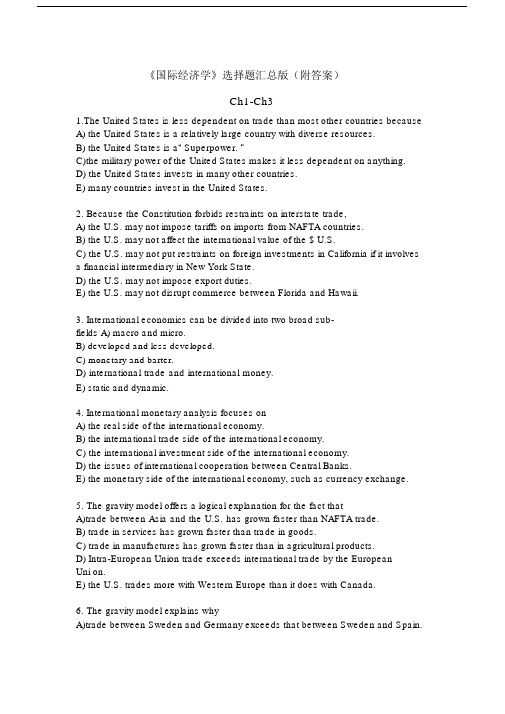
《国际经济学》选择题汇总版(附答案)Ch1-Ch31.The United States is less dependent on trade than most other countries becauseA)the United States is a relatively large country with diverse resources.B)the United States is a“ Superpower. ”C)the military power of the United States makes it less dependent on anything.D)the United States invests in many other countries.E)many countries invest in the United States.2. Because the Constitution forbids restraints on interstate trade,A)the U.S. may not impose tariffs on imports from NAFTA countries.B)the U.S. may not affect the international value of the $ U.S.C)the U.S. may not put restraints on foreign investments in California if it involves a financial intermediary in New York State.D)the U.S. may not impose export duties.E)the U.S. may not disrupt commerce between Florida and Hawaii.3.International economics can be divided into two broad sub-fields A) macro and micro.B) developed and less developed.C) monetary and barter.D) international trade and international money.E) static and dynamic.4.International monetary analysis focuses onA)the real side of the international economy.B)the international trade side of the international economy.C)the international investment side of the international economy.D)the issues of international cooperation between Central Banks.E)the monetary side of the international economy, such as currency exchange.5.The gravity model offers a logical explanation for the fact thatA)trade between Asia and the U.S. has grown faster than NAFTA trade.B) trade in services has grown faster than trade in goods.C) trade in manufactures has grown faster than in agricultural products.D) Intra-European Union trade exceeds international trade by the EuropeanUni on.E) the U.S. trades more with Western Europe than it does with Canada.6.The gravity model explains whyA)trade between Sweden and Germany exceeds that between Sweden and Spain.B)countries with oil reserves tend to export oil.C)capital rich countries export capital intensive products.D)intra-industry trade is relatively more important than other forms of tradebetween neighboringcountries.E)European countries rely most often on natural resources.7. Why does the gravity model work?A)Large economies became large because they were engaged in international trade.B)Large economies have relatively large incomes, and hence spend more on governm ent promotion of trade and investment.C)Large economies have relatively larger areas which raises the probability that a pro ductive activity will take place within the borders of that country.D)Large economies tend to have large incomes and tend to spend more on impor ts.E) Large economies tend to avoid trading with small economies.8.We see that the Netherlands, Belgium, and Ireland trade considerably more with the United States than with many other countries.A)This is explained by the gravity model, since these are all large countries.B)This is explained by the gravity model, since these are all small countries.C)This fails to be consistent with the gravity model, since these are smallcountri es.D)This fails to be consistent with the gravity model, since these are large countries.E)This is explained by the gravity model, since they do not share borders.9.In the present, most of the exports from Chinaare A) manufactured goods.B) services.C)primary products including agricultural.D) technology intensive products.E) overpriced by world market standards.10.A country engaging in trade according to the principles of comparative advantage gains from trade because itA) is producing exports indirectly more efficiently than it could alternatively.B) is producing imports indirectly more efficiently than it could domestically.C) is producing exports using fewer labor units.D) is producing imports indirectly using fewer labor units.E) is producing exports while outsourcing services.11.The Ricardian model attributes the gains from trade associated with the principle o f comparative advantage result toA) differences in technology.B)differences in preferences.C)differences in labor productivity.D)differences in resources.E)gravity relationships among countries.12. A nation engaging in trade according to the Ricardian model will find itsconsump tion bundleA)inside its production possibilities frontier.B)on its production possibilities frontier.C)outside its production possibilities frontier.D)inside its trade-partner's production possibilities frontier.E)on its trade-partner's production possibilities frontier.13.Assume that labor is the only factor of production and that wages in the United Sta tes equal $20 per hour while wages in Japan are $10 per hour. Production costs would be lower in the United States as compared to Japan ifA)U.S. labor productivity equaled 40 units per hour and Japan's 15 units per hour.B)U.S. labor productivity equaled 30 units per hour and Japan's 20 units per hour.C)U.S. labor productivity equaled 20 units per hour and Japan's 30 units per hour.D)U.S. labor productivity equaled 15 units per hour and Japan's 25 units per hour.E)U.S. labor productivity equaled 15 units per hour and Japan's 40 units per hour.14.In a two-country, two-product world, the statement“ Germanyenjoys acomparativ e advantage over France in autos relative toships ”is equivalent toA) France having a comparative advantage over Germany in ships.B) France having a comparative disadvantage compared to Germany in autos and ship s.C) Germany having a comparative advantage over France in autos and ships.D) France having no comparative advantage over Germany.E) France should produce autos.15.If the United States' production possibility frontier was flatter to the widget axis, whereas Germany's was flatter to the butter axis, we know thatA)the United States has no comparative advantageB)Germany has a comparative advantage in butter.C)the U.S. has a comparative advantage in butter.D)Germany has comparative advantages in both products.E)the U.S. has a comparative disadvantage in widgets.Ch4-Ch51.The Ricardian model of international trade demonstrates that trade can bemutually beneficial. Why, then, do governments restrict imports of some goods?A)Trade can have substantial effects on a country's distribution of income.B)The Ricardian model is often incorrect in its prediction that trade can bemutually beneficial.C)Import restrictions are the result of trade wars between hostile countries.D)Imports are only restricted when foreign-made goods do not meet domestic standar ds of qualityE) Restrictions on imports are intended to benefit domestic consumers.2.Japan's trade policies with regard to rice reflect the fact thatA) japanese rice farmers have significant political power.B) Japan has a comparative advantage in rice production and therefore exports most o f its rice crop.C) there would be no gains from trade available to Japan if it engaged in free trade in r ice.D) there are gains from trade that Japan captures by engaging in free trade in rice.E) Japan imports most of the rice consumed in the country.3.In the specific factors model, which of the following is treated as a specific factor?A)LaborB)LandC)ClothD)FoodE)Technology4.The specific factors model assumes that there are ________ goods and ________ fa ctor(s) of production.A) two; threeB) two; two C)two; one D)three; two E)four; three5.The slope of a country's production possibility frontier with cloth measured on the horizontal and food measured on the vertical axis in the specific factors model is equa l to ________ and it ________ as more cloth is produced.A)-MPLF/MPLC; becomes steeperB)-MPLF/MPLC; becomes flatterC)-MPLF/MPLC; is constantD)-MPLC/MPLF; becomes steeperE)-MPLC/MPLF; is constant6.Under perfect competition, the equilibrium price of labor used to produce clothwill be equal toA)the slope of the production possibility frontier.B)the average product of labor in the production of cloth times the price of cloth.C)the ratio of the marginal product of labor in the production of cloth to the marginal product of labor in the production of food times the ratio of the price of cloth. to the price of food.D)the marginal product of labor in the production of cloth times the price of cloth.E)the price of cloth divided by the marginal product of labor in the production of clot h.7.In the specific factors model, which of the following will increase the quantity ofla bor used in cloth production?A)an increase in the price of cloth relative to that of foodB) an increase in the price of food relative to that ofcloth C) a decrease in the price of laborD) an equal percentage decrease in the price of food and clothE) an equal percentage increase in the price of food and cloth8.A country that does not engage in trade can benefit from trade only ifA)it has an absolute advantage in at least one good.B)it employs a unique technology.C)pre-trade and free-trade relative prices are not identical.D)its wage rate is below the world average.E)pre-trade and free-trade relative prices are identical.9.In the specific factors model, the effects of trade on welfare are ________ for mobil e factors, ________ for fixed factors used to produce the exported good, and ________ for fixed factors used to produce the imported good.A)ambiguous; positive; negativeB) ambiguous; negative; positive C)positive; ambiguous; ambiguous D)negative; ambiguous; ambiguous E)positive; positive; positive10.The effect of trade on specialized employees of import-competing industries willb e ________ jobs and ________ pay because they are relatively ________.A)fewer; lower; mobileB)fewer; lower; immobileC)more; lower; immobileD)more; higher; mobileE)more; higher; immobile11. There is a bias in the political process against free trade becauseA)there is a high correlation between the volume of imports and the unemployment ra te.B)the gains from free trade cannot be measured.C)those who gain from free trade can't compensate those who lose.D)foreign governments make large donations to U.S. political campaigns.E) those who lose from free trade are better organized than those who gain.12.In the 2-factor, 2 good Heckscher-Ohlin model, the two countries differin A)tastes and preferences.B)military capabilities.C)the size of their economies.D)relative abundance of factors of production.E)labor productivities.13.If a country produces good Y (measured on the vertical axis) and good X (measure d on the horizontal axis), then the absolute value of the slope of its production possibil ity frontier is equal toA)the opportunity cost of good X.B) the price of good X divided by the price of good Y.C) the price of good X divided by the price of goodY. D) the opportunity cost of good Y.E)the cost of capital (assuming that good Y is capital intensive) divided by the costof labor.14.In the 2-factor, 2 good Heckscher-Ohlin model, trade will ________ the owners ofa country's ________ factor and will ________ the good that uses that factor intensiv ely.A)benefit; abundant; exportB)harm; abundant; importC)benefit; scarce; exportD)benefit; scarce; importE)harm; scarce; export15.The assumption of diminishing returns in the Heckscher-Ohlin model means that, unlike in the Ricardian model, it is likely thatA) countries will consume outside their production possibility frontier.B) countries will benefit from free international trade.C) countries will not be fully specialized in one product.D)comparative advantage will not determine the direction of trade.E)global production will decrease under trade.16.If Japan is relatively capital rich and the United States is relatively land rich, and if food is relatively land intensive then trade between these two, formerly autarkic coun tries will result inA)an increase in the relative price of food in the U.S.B)an increase in the relative price of food in Japan.C)a global increase in the relative price of food.D)a decrease in the relative price of food in both countries.E)an increase in the relative price of food in both countries.17.Starting from an autarky (no-trade) situation with Heckscher-Ohlin model, if Coun try H is relatively labor abundant, then once trade beginsA) rent will be unchanged but wages will rise in H.B) wages and rents should rise in H.C) wages and rents should fall in H.D) wages should fall and rents should rise in H.E) wages should rise and rents should fall in H.18.The Leontieff ParadoxA)failed to support the validity of the Heckscher-Ohlin model.B)supported the validity of the Ricardian theory of comparative advantage.C)supported the validity of the Heckscher-Ohlin model.D)failed to support the validity of the Ricardian theory.E)proved that the U.S. economy is different from all others.19. Which of the following is an assertion of the Heckscher-Ohlin model?A)Factor price equalization will occur only if there is costless mobility of all factors a cross borders.B)An increase in a country's labor supply will increase production of both the capital-intensive and the labor-intensive good.C)In the long-run, labor is mobile and capital is not.D)The wage-rental ratio determines the capital-labor ratio in a country's industr ies.E)Factor endowments determine the technology that is available to a country, which determines the good in which the country will have a comparative advantage.20. Which of the following is an assertion of the Heckscher-Ohlin model?A)An increase in a country's labor supply will increase production of the labor-i ntensive good and decrease production of the capital-intensive good.B)An increase in a country's labor supply will increase production of both the capital-intensive and the labor-intensive good.C)In the long-run, labor is mobile and capital is not.D)Factor price equalization will occur only if there is costless mobility of all factors a cross borders.E)Factor endowments determine the technology that is available to a country, which determines the good in which the country will have a comparative advantage.Ch6-Ch101.If the ratio of price of cloth (PC) divided by the price of food (PF) increases in thei nternational marketplace, thenA)the terms of trade of cloth exporters will improve.B)all countries would be better off.C)the terms of trade of food exporters will improve.D)the terms of trade of all countries will improve.E) the terms of trade of cloth exporters will worsen.2.If the ratio of price of cloth (PC) divided by the price of food (PF) increases in thei nternational marketplace, thenA)world relative quantity of cloth supplied will increase.B)world relative quantity of cloth supplied and demanded will increase.C)world relative quantity of cloth supplied and demanded will decrease.D)world relative quantity of cloth demanded will decrease.E)world relative quantity of food will increase.3.If the U.S. (a large country) imposes a tariff on its imported good, this will tend toA)have no effect on terms of trade.B)improve the terms of trade of the United States.C)improve the terms of trade of all countries.D)because a deterioration of U.S. terms of trade.E)raise the world price of the good imported by the United States.4.If Slovenia were a large country in world trade, then if it instituted a large set of sub sidies for its exports, this mustA)decrease its marginal propensity to consume.B)have no effect on its terms of trade.C)improve its terms of trade.D)harm its terms of trade.E)harm world terms of trade.5.Internal economies of scale arise when the cost per unitA)falls as the average firm grows larger.B)rises as the industry grows larger.C)falls as the industry grows larger.D)rises as the average firm grows larger.E)remains constant over a broad range of output.6. External economies of scale will ________ average cost when output is ________ by _______.A)reduce; increased; the industryB)reduce; increased; a firmC)increase; increased; a firmD)increase; increased; the industryE)reduce; reduce; the industry7.If some industries exhibit internal increasing returns to scale in each country, we sh ould not expect to seeA) perfect competition in these industries.B) intra-industry trade between countries.C)inter-industry trade between countries.D)high levels of specialization in both countries.E)increased productivity in both countries.8.A learning curve relates ________ to ________ and is a case of ________ returns.A) unit cost; cumulative production; dynamic decreasing returnsB)output per time period; long-run marginal cost; dynamic increasing returnsC)unit cost; cumulative production; dynamic increasing returnsD)output per time period; long-run marginal cost; dynamic decreasing returnsE)labor productivity; education; increasing marginal returns9.Patterns of interregional trade are primarily determined by ________ rather than __ ______ because factors of production are generally ________.A)external economies; natural resources; mobileB)internal economies; external economies; mobileC)external economies; population; immobileD)internal economies; population; immobileE)population; external economies; immobile10.Monopolistic competition is associatedwith A) product differentiation.B) price-taking behavior.C) explicit consideration at the firm level of the strategic impact of other firms' pricing decisions. D) high profit margins in the long run.E) increasing returns to scale.11.A firm in long-run equilibrium under monopolistic competition will earnA)positive monopoly profits because each sells a differentiated product.B)zero economic profits because of free entryC)positive oligopoly profits because each firm sells a differentiated product.D)negative economic profits because it has economies of scale.E)positive economic profit if it engages in international trade.12.The most common form of price discrimination in international tradeis A) dumping.B) non-tariff barriers.C) Voluntary Export Restraints.D) preferential trade arrangements.E) product boycotts.13.Consider the following two cases. In the first, a U.S. firm purchases 18% of a forei gn firm. In the second, a U.S. firm builds a new production facility in a foreign countr y. Both are ________, with the first referred to as ________ and the second as ______ __.A)foreign direct investment (FDI) outflows; brownfield; greenfieldB)foreign direct investment (FDI) inflows; greenfield; brownfieldC)foreign direct investment (FDI) outflows; greenfield; brownfieldD)foreign direct investment (FDI) inflows; brownfield; greenfieldE)foreign direct investment (FDI); inflows; outflows14. Specific tariffs areA)import taxes stated in specific legal statutes.B)import taxes calculated as a fixed charge for each unit of imported goods.C)import taxes calculated as a fraction of the value of the imported goods.D)the same as import quotas.E)import taxes calculated based solely on the origin country.15.A problem encountered when implementing an "infant industry" tariff isthat A) domestic consumers will purchase the foreign good regardless of thetariff. B) the industry may never "mature."C)most industries require tariff protection when they are mature.D)the tariff may hurt the industry's domestic sales.E)the tariffs fail to protect the domestic producers.16.In the country levying the tariff, the tariff will A)increase both consumer and producer surplus.B) decrease both the consumer and producer surplus.C) decrease consumer surplus and increase producer surplus.D) increase consumer surplus and decrease producer surplus.E) decrease consumer surplus but leave producers surplus unchanged.17.If the tariff on computers is not changed, but domestic computer producers shift fr om domestically produced semiconductors to imported components, then the effective rate of protection in the computer industry willA) increase.B) decreaseC) remain the same.D)depend on whether computers are PCs or "Supercomputers."E)no longer apply.18.When a government allows raw materials and other intermediate products to enter a country duty free, this generally results in a(an)A) effective tariff rate less than the nominal tariff rate.B) nominal tariff rate less than the effective tariff rate.C) rise in both nominal and effective tariff rates.D) fall in both nominal and effective tariff rates. E) rise in only the effective tariff rat e.19.Should the home country be "large" relative to its trade partners, its imposition ofa tariff on imports would lead to an increase in domestic welfare if the terms of thetra de rectangle exceed the sum of theA) revenue effect plus redistribution effect.B) protective effect plus revenue effect.C) consumption effect plus redistribution effect.D)production distortion effect plus consumption distortion effect.E)terms of trade gain.20.The efficiency case made for free trade is that as trade distortions such as tariffs ar e dismantledand removed,A) government tariff revenue will decrease, and therefore national economic welfare will decreaseB) government tariff revenue will decrease, and therefore national econo mic welfare will increase.C) deadweight losses for producers and consumers will decrease, henceincreasin g national economic welfare.D)deadweight losses for producers and consumers will decrease, hence decreasing na tional economic welfare.E)government tariff revenue will increase, hence increasing national economic welfar e.21.Which organization determines procedures for the settlement of international trade disputes?A)World BankB)World Trade OrganizationC)International Monetary OrganizationD)International Bank for Reconstruction and DevelopmentE)The League of Nations22.Today U.S. protectionism is concentratedin A) high-tech industries.B) labor-intensive industries.C) industries in which Japan has a comparative advantage.D)computer intensive industries.E)capital-intensive industries.23.The quantitative importance of U.S. protection of the domestic clothing industryis best explained by the fact thatA)this industry is an important employer of highly skilled labor.B)this industry is an important employer of low skilled labor.C)most of the exporters of clothing into the U.S. are poor countries.D)this industry is a politically well organized sector in the U.S.E)the technology involved is very advanced.欢迎下载1124.The optimum tariff is most likely to applyto A) a small tariff imposed by a small country.B) a small tariff imposed by a large country. C)a large tariff imposed by a small country. D) alarge tariff imposed by a large country. E) anad valorem tariff on a small country.25.The median voter modelA)works well in the area of trade policy.B)is not intuitively reasonable.C)tends to result in biased tariff rates.D)does not work well in the area of trade policy.E)is not widely practiced in the United States.欢迎下载12。
中南财大国际经济学双语期末试卷
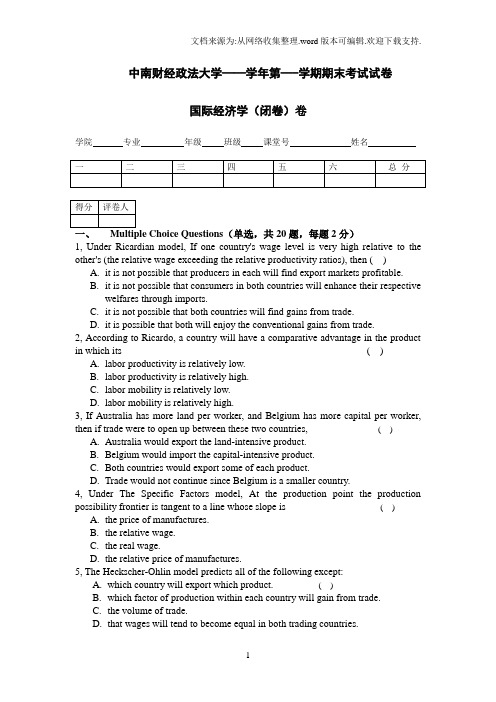
中南财经政法大学——学年第—-学期期末考试试卷国际经济学(闭卷)卷学院专业年级班级课堂号姓名(单选,共20题,每题2分)1, Under Ricardian model, If one country's wage level is very high relative to the other's (the relative wage exceeding the relative productivity ratios), then ( )A.it is not possible that producers in each will find export markets profitable.B.it is not possible that consumers in both countries will enhance their respectivewelfares through imports.C.it is not possible that both countries will find gains from trade.D.it is possible that both will enjoy the conventional gains from trade.2, According to Ricardo, a country will have a comparative advantage in the product in which its ( )bor productivity is relatively low.bor productivity is relatively high.bor mobility is relatively low.bor mobility is relatively high.3, If Australia has more land per worker, and Belgium has more capital per worker, then if trade were to open up between these two countries, ( )A.Australia would export the land-intensive product.B.Belgium would import the capital-intensive product.C.Both countries would export some of each product.D.Trade would not continue since Belgium is a smaller country.4, Under The Specific Factors model, At the production point the production possibility frontier is tangent to a line whose slope is ( )A.the price of manufactures.B.the relative wage.C.the real wage.D.the relative price of manufactures.5, The Heckscher-Ohlin model predicts all of the following except:A.which country will export which product. ( )B.which factor of production within each country will gain from trade.C.the volume of trade.D.that wages will tend to become equal in both trading countries.6, If P C / P F were to increase in the international marketplace, then ( )A.all countries would be better off.B.the terms of trade of cloth exporters improve.C.the terms of trade of food exporters improve.D.the terms of trade of all countries improve.7, When the production possibility frontier shifts out relatively more in one direction, we have ( )A.biased growth.B.unbiased growth.C.immiserizing growth.D.balanced growth.8, If Slovenia were a large country in world trade, then if it instituted a large set of subsidies for its exports, this must ( )A.cause retaliation on the part of its trade partners.B.harm Slovenia's real income.C.improve Slovenia's real income.D.improve the real income of its trade partners.9, A lower tariff on imported steel would most likely benefit ( )A.foreign producers at the expense of domestic consumers.B.domestic manufacturers of steel.C.domestic consumers of steel.D.workers in the steel industry.10, If the poor AID(aid of international development) recipient countries have a higher marginal propensity to consume each and every product than does the United States, then such aid will ( )A.worsen the U.S. terms of trade.B.improve the U.S. terms of trade.C.leave the world terms of trade unaffected.D.worsen the terms of trade of both donor and recipient countries.11, A large country experiencing import-biased economic growth will tend to experience ( )A.no change in terms of trade.B.deteriorating terms of trade.C.improving terms of trade.D.immiserizing terms of trade.12, The most common form of price discrimination in international trade is ( )A.non-tariff barriers.B.V oluntary Export Restraints.C.dumping.D.preferential trade arrangements.13, An appreciation of a country’s currency ( )A.decreases the relative price of its exports and lowers the relative price ofits imports.B.raises the relative price of its exports and raises the relative price of itsimports.C.lowers the relative price of its exports and raises the relative price of itsimports.D.raises the relative price of its exports and lowers the relative price of itsimports.14, Under Purchasing Power Parity, ( )A.E$/E = P i US/ P i E.B.E$/E = P i E / P i US.C.E$/E = P US / P E.D.E$/E = P E / P US.15, Under the monetary approach to the exchange rate, ( )A. a reduction in the money supply will cause immediate currencydepreciation.B. a rise in the money supply will have no effect on exchange rate.C. a rise in the money supply will cause immediate currency appreciation.D. a rise in the money supply will cause a proportional long-run currencydepreciation.16, When EP*/P rises, ( )A.IM will rise.B.IM may rise or fall.C.IM will fall.D.IM is not affected.17, In the short run, a temporary increase in fiscal policy causes ( )A.a shift of the DD curve to the left, an increase in output, andcurrency appreciation.B. a shift of the DD curve to the right, an increase in output, andcurrency appreciation.C. a shift of the DD curve to the right, an increase in output, andcurrency depreciation.D.a shift of the DD curve to the left, a decrease in output, andcurrency depreciation.18, How does a rise in real income affect aggregate demand? ( )A.Y ↑→ Yd ↑→Im ↑→CA ↓→AD ↓, but Y ↑→ Yd ↑→ C ↑→ AD ↑ by more.B.Y ↑→ Yd ↑→Im ↓→CA ↓→AD ↓, but Y ↑→ Yd ↑→ C ↑→ AD ↑ by more.C.Y ↑→ Yd ↑→Im ↑→CA ↑→AD ↑, and Y ↑→ Yd ↑→ C ↑→ AD ↑.D.Y ↑→ Yd ↑→Im ↑→CA ↓→AD ↓, but Y ↑→ Yd ↑→ C ↑→ AD ↑ by less. 19, Under fixed rates, which one of the following statements is the most accurate? ( )A.Monetary policy can affect only output.B.Monetary policy can affect only employment.C.Monetary policy can affect only international reserves.D.Monetary policy can not affect international reserves.20, Under fixed exchange rate, which one of the following statements is the most accurate? ( )A.Devaluation causes a rise in output.B.Devaluation causes a decrease in output.C.Devaluation has no effect on output.共5题,每题6分)1,An Economy can produce goods A using labor and capital and goods B using labor and land. Calculate the effects of the fall in the relative price of goods B on the income of the specific factors capital and land.2, suppose that one country subsidizes its exports and the other country imposes a countervailing tariff that offsets its effect, so that in the end relative price in the second country are unchanged. What happens to the terms of trade? What about welfare in the two countries?3, Describe the pattern of trade under H-O model.4, International trade leads to complete equalization of factor prices. Discuss.5,What is the Fisher Effect? Provide an example.6,Suppose E is fixed at E0 and that the asset markets are in equilibrium.Suddenly output rises. What monetary measures keep the current exchange rate constant given unchanged expectations about the future rate?(共1题,10分)A small country imports peanuts at the price of $10 per bag. The demand curve is D=400-10P. The supply curve is S=50+5PDetermine the free trade equilibrium. Then calculate and graph the following effects: A: The increase in the domestic priceB: The quota rentsC: The consumption distortion lossD: The production distortion loss.四.Essay Questions(共2题,每题10分)1,Comparing the interindustry trade and intraindustry trade.2, Construct a table that will summarize the effects of money market and output market changes on the long-run nominal dollar/ euro exchange rate.中南财经政法大学---------学年第----学期期末考试答案和评分标准课程名称:《国际经济学》()卷课程代号:_02013020_考试形式:闭卷使用对象:1,Because good B uses land, a fall in its relative price will result in a fall in rental rates on land, and an increase in the return to capital.2,The first country is worse off by subsidy and a foreign tariff while the second one is better off by subsidy in the first one and its own tariff.3, Countries tend to export goods whose production is intensive in factors with which they are abundantly endowed.4,This statement is typically "true…but". Under a strict and limited set of assumptions, such as the original Heckscher-Ohlin model which excludes country specific technologies; non- homothetic tastes; factor intensity reversals; large country differences in (relative) factor abundances, and more factors than goods, then it may be demonstrated that internal consistency demands that the above stated sentence is "true". However, the minute one relaxes any of the above listed assumptions one may easily identify solutions, which contradict the factor price equalization theorem.5, All else equal, a rise in a country’s expected inflation rate will eventually cause an equal rise in the interest rate that deposits of its currency offer. Similarly, a fall in the expected inflation rate will eventually cause a fall in the interest rate.6, •Since output rises, demand for domestic money rises; this increase in money demand normally pushes the domestic interest rate upwards. To prevent appreciation of home currency (given E0is expected) the central bank buys foreign assets in foreign exchange market.•This eliminates excess demand for domestic money because the central bank issues money to pay for the foreign assets it buys.•The bank increases the money supply in this way until asset markets clear with E = E0 and R = R*.三.计算题A: D-S=50,P=20(3分)B: (20-10)*50=500(3分)C: 100*10*0.5=500(2分)D:50*10*0.5=250(2分)四.论述题1, Interindustry trade reflect comparative advantage while intraindustry trade doesnot reflect comparative advantage.(4分)The pattern of intraindustry trade itself is unpredictable while interindustry trade is predictable.(3分)The relative importance of intraindustry and interindustry trade depends on how similar countries are.(3分)。
国际经济学_中南财经政法大学中国大学mooc课后章节答案期末考试题库2023年
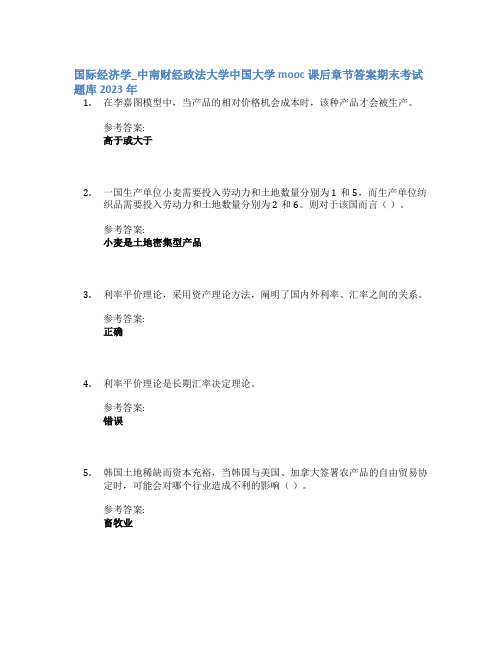
国际经济学_中南财经政法大学中国大学mooc课后章节答案期末考试题库2023年1.在李嘉图模型中,当产品的相对价格机会成本时,该种产品才会被生产。
参考答案:高于或大于2.一国生产单位小麦需要投入劳动力和土地数量分别为1和5,而生产单位纺织品需要投入劳动力和土地数量分别为2和6。
则对于该国而言()。
参考答案:小麦是土地密集型产品3.利率平价理论,采用资产理论方法,阐明了国内外利率、汇率之间的关系。
参考答案:正确4.利率平价理论是长期汇率决定理论。
参考答案:错误5.韩国土地稀缺而资本充裕,当韩国与美国、加拿大签署农产品的自由贸易协定时,可能会对哪个行业造成不利的影响()。
参考答案:畜牧业6.下面哪个原因导致里昂惕夫之谜的出现()。
参考答案:赫尔谢尔-俄林模型的逻辑错误7.以下哪项陈述最准确?()参考答案:绝对PPP意味着相对PPP成立8.假定两个国家甲和乙的要素禀赋如下。
两国即将签署自由贸易协定,则谁会反对?( )国家要素禀赋甲乙劳动力 45 20资本存量 15 10参考答案:乙国的工人_甲国的资本所有者9.本国居民包括()。
参考答案:跨国公司的高级管理人员10.相对于比利时而言,澳大利亚拥有较高的土地、劳动力,双方进行贸易的话,有()。
参考答案:澳大利亚的工人会受损_比利时的土地所有者会受损_澳大利亚的土地所有者会获益_比利时的工人会获益11.当国民储蓄过剩时,国际收支中的经常账户必然是()。
顺差12.贸易保护的目的之一在于保护国内就业。
()参考答案:正确13.贸易保护成本是指一国政府在实施贸易保护政策时付出的代价,包括消费者剩余的减少、政府补贴等。
()参考答案:正确14.在浮动汇率制度下,顺差会导致本币升值(外币贬值)和国际储备资产减少,逆差则反之。
参考答案:错误15.民用飞机产业具备不完全竞争、规模经济、外部经济等特征,是非常标准的战略性产业。
()参考答案:正确16.战略性贸易政策是指在不完全竞争市场结构和存在规模经济的条件下,政府通过补贴等贸易保护手段,扶持本国战略性产业的成长,增强在国际市场的竞争地位。
国际经济学试题及答案(题库)
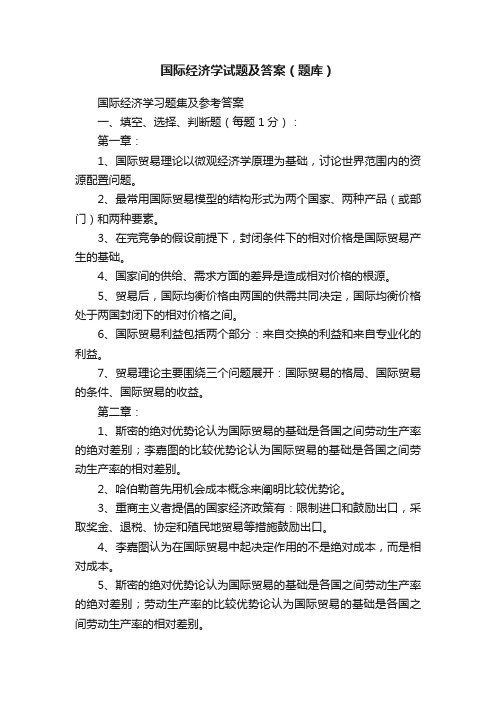
国际经济学试题及答案(题库)国际经济学习题集及参考答案一、填空、选择、判断题(每题1分):第一章:1、国际贸易理论以微观经济学原理为基础,讨论世界范围内的资源配置问题。
2、最常用国际贸易模型的结构形式为两个国家、两种产品(或部门)和两种要素。
3、在完竞争的假设前提下,封闭条件下的相对价格是国际贸易产生的基础。
4、国家间的供给、需求方面的差异是造成相对价格的根源。
5、贸易后,国际均衡价格由两国的供需共同决定,国际均衡价格处于两国封闭下的相对价格之间。
6、国际贸易利益包括两个部分:来自交换的利益和来自专业化的利益。
7、贸易理论主要围绕三个问题展开:国际贸易的格局、国际贸易的条件、国际贸易的收益。
第二章:1、斯密的绝对优势论认为国际贸易的基础是各国之间劳动生产率的绝对差别;李嘉图的比较优势论认为国际贸易的基础是各国之间劳动生产率的相对差别。
2、哈伯勒首先用机会成本概念来阐明比较优势论。
3、重商主义者提倡的国家经济政策有:限制进口和鼓励出口,采取奖金、退税、协定和殖民地贸易等措施鼓励出口。
4、李嘉图认为在国际贸易中起决定作用的不是绝对成本,而是相对成本。
5、斯密的绝对优势论认为国际贸易的基础是各国之间劳动生产率的绝对差别;劳动生产率的比较优势论认为国际贸易的基础是各国之间劳动生产率的相对差别。
6、在李嘉图模型中,生产可能性边界线方程是一个线性方程式,表示A、B两国的PPF曲线是一条直线段。
7、重商主义者提倡的国家经济政策有:限制进口和鼓励出口,采取奖金、退税、协定和殖民地贸易等措施鼓励出口。
8、李嘉图认为在国际贸易中起决定作用的不是绝对成本,而是相对成本。
9、机会成本概念表明:彼种选择的机会成本就构成此种选择的机会成本。
选择题:1、首先用机会成本理论来解释比较优势原理的学者是: C、A、李嘉图B、罗布津斯基C、哈伯勒D、穆勒第三章:1、要素禀赋理论最初是由赫克歇尔和俄林提出的,后经萨缪尔森等人加工不断完善。
国际经济学_南京财经大学中国大学mooc课后章节答案期末考试题库2023年

国际经济学_南京财经大学中国大学mooc课后章节答案期末考试题库2023年1.二战结束之后,大多数国家都把英镑作为关键货币。
参考答案:错误2.共同市场区别于关税同盟的是()。
参考答案:要素自由流动3.最惠国待遇原则的例外是()参考答案:保障动植物及人民生命安全的所有措施4.经济发展阶段不同的国家组成的一体化是()。
参考答案:垂直一体化5.按贸易壁垒取消程度划分,一体化程度最低的是()。
参考答案:优惠贸易安排6.设A、B、C三国对进口自行车内胎征税如下:A国15%,B国12%,C国11%;三国结为一体化组织后,组织内部相互免关税,对外A国征收15%进口税,B国征12%进口税,C国也征12%进口税,则这种一体化形式是()。
参考答案:自由贸易区7.WTO的目标是形成一个完整的、更具活力的永久性的多边贸易体制。
参考答案:正确8.WTO及其协议是永久性的,关税与贸易总协定是临时性的。
参考答案:正确9.非歧视原则只适用于货物贸易领域。
参考答案:错误10.普惠制是一种相互优惠的关税待遇,体现了非歧视原则。
参考答案:错误11.只有当关税同盟具有贸易创造效果时,贸易量才会扩大。
参考答案:错误12.产业间贸易是同一产业基本上是单向流动的,而产业内贸易是双向流动的,因此产业内贸易又叫双向贸易。
参考答案:正确13.根据产业内贸易理论,国际贸易产生的原因包括( )。
参考答案:消费者需求偏好的差异_市场的不完全性_规模经济14.国际贸易中的垄断竞争市场的特点有()。
参考答案:市场上存在众多的厂商和消费者_长期内,厂商可以自由进出市场_厂商供给差别产品15.产品差别包括()。
参考答案:同一类型产品在品牌上的差别_同一类型产品在规格上的差别_同一类型产品在商标上的差别_同一类型产品在包装上的差别16.布雷顿森林体系确立了()在国际货币体系中的中心地位。
参考答案:美元17.幼稚工业理论认为应该设置暂时性关税以使新兴产业在磨练中提高效率。
南京财经大学继续教育《国际经济学》三套试题答案
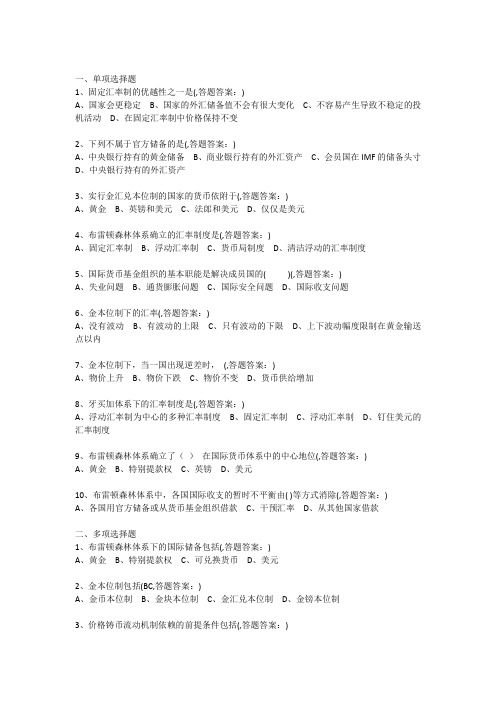
一、单项选择题1、固定汇率制的优越性之一是(,答题答案:)A、国家会更稳定B、国家的外汇储备值不会有很大变化C、不容易产生导致不稳定的投机活动D、在固定汇率制中价格保持不变2、下列不属于官方储备的是(,答题答案:)A、中央银行持有的黄金储备B、商业银行持有的外汇资产C、会员国在IMF的储备头寸D、中央银行持有的外汇资产3、实行金汇兑本位制的国家的货币依附于(,答题答案:)A、黄金B、英镑和美元C、法郎和美元D、仅仅是美元4、布雷顿森林体系确立的汇率制度是(,答题答案:)A、固定汇率制B、浮动汇率制C、货币局制度D、清洁浮动的汇率制度5、国际货币基金组织的基本职能是解决成员国的()(,答题答案:)A、失业问题B、通货膨胀问题C、国际安全问题D、国际收支问题6、金本位制下的汇率(,答题答案:)A、没有波动B、有波动的上限C、只有波动的下限D、上下波动幅度限制在黄金输送点以内7、金本位制下,当一国出现逆差时,(,答题答案:)A、物价上升B、物价下跌C、物价不变D、货币供给增加8、牙买加体系下的汇率制度是(,答题答案:)A、浮动汇率制为中心的多种汇率制度B、固定汇率制C、浮动汇率制D、钉住美元的汇率制度9、布雷顿森林体系确立了()在国际货币体系中的中心地位(,答题答案:)A、黄金B、特别提款权C、英镑D、美元10、布雷顿森林体系中,各国国际收支的暂时不平衡由( )等方式消除(,答题答案:)A、各国用官方储备或从货币基金组织借款C、干预汇率D、从其他国家借款二、多项选择题1、布雷顿森林体系下的国际储备包括(,答题答案:)A、黄金B、特别提款权C、可兑换货币D、美元2、金本位制包括(BC,答题答案:)A、金币本位制B、金块本位制C、金汇兑本位制D、金镑本位制3、价格铸币流动机制依赖的前提条件包括(,答题答案:)A、国际间没有大量的资本流动B、货币数量论C、较高的进出口价格弹性D、国际部进行干预4、牙买加体系下调节国际收支的多种渠道包括(,答题答案:)A、通过汇率变动调节国际收支B、国际融资C、加强国际协调D、运用国内经济政策5、国际货币基金组织的职能包括(BC,答题答案:)A、监督国际汇率B、提供国际信贷C、协调国际货币关系D、监督各国货币政策三、判断题1、价格-铸币流动机制是以货币数量论为前提的(,答题答案:)A、是B、否2、在金本位制下,各国货币的汇率固定,没有任何波动(,答题答案:)A、是B、否3、在布雷顿森林体系中,外汇与黄金并列,共同构成国际储备资产的主要部分(,答题答案:)A、是B、否4、金块本位制和金汇兑本位制由于不具备金币本位制的一系列特点,因此,也称为不完全或残缺不全的金本位制(,答题答案:)A、是B、否5、在金本位制下,国际收支存在一种自动调节机制(,答题答案:)A、是B、否6、牙买加体系下,固定汇率制与浮动汇率制并存(,答题答案:)A、是B、否7、金本位时期的汇率稳定性证明,将货币与黄金挂钩可以保证国际经济的稳定(,答题答案:)A、是B、否8、布雷顿森林体系中,汇率的波动是在基金组织的监督下,由各国干预外汇市场来调节(,答题答案:)A、是B、否9、国际金本位制度下,各国货币自由兑换,对国际支付一般不采取限制措施(,答题答案:)A、是B、否10、布雷顿森林体系中,黄金的流动是完全自由的(,答题答案:)A、是B、否一、单项选择题1、只有在以下何种状况时,总需求的扩张才可以实现内部及外部平衡?(,答题答案:)A、国际收支盈余和高失业率B、国际收支盈余和通货膨胀C、国际收支赤字和通货膨胀D、国际收支赤字和高失业率2、以下哪一项不被作为政府维护固定汇率的战略? (,答题答案:)A、实施外汇管制B、买入和卖出外汇C、通过调节本国利率而改变本币的供求D、利用武力3、通过支出水平的变动来调节社会需求总水平的政策叫做(,答题答案:)A、支出增减政策B、支出转换政策C、汇率政策D、直接管制政策4、如果美国货币当局要逆向调节,它将(,答题答案:)A、在美元对日元贬值时卖出美元B、在美元对日元升值时卖出美元C、在日元对美元升值时买入美元D、在美元对日元升值时买入美元5、在开放条件下,一国国民收入均衡水平取决于国内消费、国内投资、国内政府开支以及(,答题答案:)A、国内进口B、国内出口C、国内净出口D、国内净资本流出6、政府会愿意使本币贬值,如果(,答题答案:)A、出口者拥有很强的游说力量B、进口品购买者拥有很强的游说力量C、决策者对国内高通胀率表示担忧D、外国政府让其这样做7、在一国收入水平不变的情况下,用于分析汇率变动以及进出口商品价格变动对贸易收支,以及国际收支失衡调节机理的理论称为(,答题答案:)A、吸收分析法B、货币分析法C、弹性分析法D、乘数分析法8、贬值对国内物价的影响是(,答题答案:)A、通缩B、通胀C、不变D、只是部分产品价格变化9、一国货币贬值后,国际收支(,答题答案:)A、恶化B、改善C、先改善后恶化D、先恶化后改善10、当政府采取紧缩政策减少国民收入时,可能的结果是(,答题答案:)A、进口减少B、出口减少C、国际收支不变D、国际收支恶化二、多项选择题1、J曲线效应发生的原因是(BC,答题答案:)A、消费者反应滞后B、生产者反应滞后C、不完全竞争D、政府干预2、紧缩政策使国民收入下降后,影响是(D,答题答案:)A、出口减少B、进口减少C、国际收支不变D、逆差下降3、本币贬值的可能影响是(C,答题答案:)A、通胀B、通缩C、贸易条件改变不确定D、贸易条件一定恶化4、乘数分析法的局限表现在(BC,答题答案:)A、忽略了国际资本流动B、假定价格不变C、假定汇率不变D、忽略了国际收支与国民收入的关系5、支出转换政策包括(D,答题答案:)A、货币政策B、财政政策C、汇率政策D、直接管制政策三、判断题1、贬值能否达到出口增加、进口减少进而改善国际收支的目的,取决于该国进口需求价格弹性DM和出口需求价格弹性DX(,答题答案:)A、是B、否2、为了同时实现内部平衡和外部平衡,可以搭配使用支出转换政策和支出增减政策(,答题答案:)A、是B、否3、本币贬值容易导致通货膨胀,从而削弱贬值带来的出口价格优势(,答题答案:)A、是B、否4、在不包括政府部门的封闭经济中,均衡国民收入水平等于预期或计划的消费额加上预期或计划的投资支出(,答题答案:)A、是B、否5、如果进口和出口需求弹性绝对值之和大于1,一国的贸易赤字就可以通过使本币升值而减少(,答题答案:)A、是B、否6、对各国政府来说,最重要的宏观经济目标可以概括为在实现内部平衡的同时保持外部平衡(,答题答案:)A、是B、否7、马歇尔-勒纳条件指的是在一系列假定条件下,一国货币贬值可以改善其国际收支的条件(,答题答案:)A、是B、否8、乘数分析法比其他国际收支调节方法的合理之处在于既考虑了经常项目也考虑了资本项目(,答题答案:)A、是B、否9、在吸收分析法中,如果已经充分就业,那么改善国际收支只能通过调整国内支出实现(,答题答案:)A、是B、否10、本币贬值后由于进口品国内价格上升,带来贸易条件恶化。
国际经济学试卷及答案3套
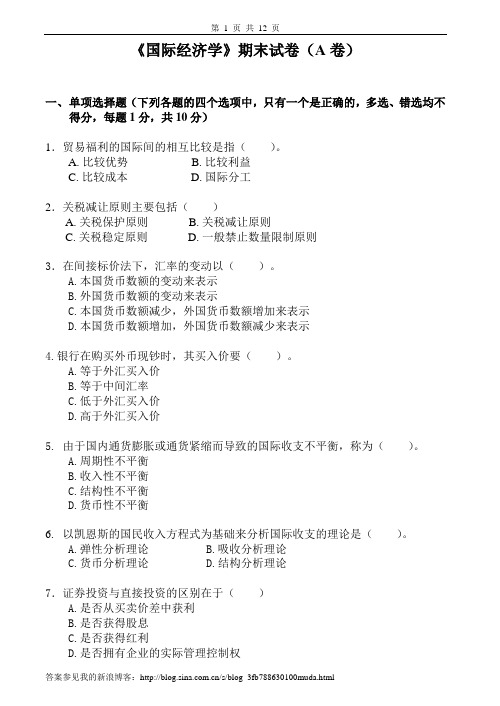
《国际经济学》期末试卷(A卷)一、单项选择题(下列各题的四个选项中,只有一个是正确的,多选、错选均不得分,每题1分,共10分)1.贸易福利的国际间的相互比较是指()。
A.比较优势B.比较利益C.比较成本D.国际分工2.关税减让原则主要包括()A.关税保护原则B.关税减让原则C.关税稳定原则D.一般禁止数量限制原则3.在间接标价法下,汇率的变动以()。
A.本国货币数额的变动来表示B.外国货币数额的变动来表示C.本国货币数额减少,外国货币数额增加来表示D.本国货币数额增加,外国货币数额减少来表示4.银行在购买外币现钞时,其买入价要()。
A.等于外汇买入价B.等于中间汇率C.低于外汇买入价D.高于外汇买入价5.由于国内通货膨胀或通货紧缩而导致的国际收支不平衡,称为()。
A.周期性不平衡B.收入性不平衡C.结构性不平衡D.货币性不平衡6. 以凯恩斯的国民收入方程式为基础来分析国际收支的理论是()。
A.弹性分析理论B.吸收分析理论C.货币分析理论D.结构分析理论7.证券投资与直接投资的区别在于()A.是否从买卖价差中获利B.是否获得股息C.是否获得红利D.是否拥有企业的实际管理控制权8. 根据欧盟的有关规定,欧元现钞开始流通的时间是()。
A.1999年1月1日B.2000年1月1日C.2002年1月1日D.2002年7月1日9.布雷顿森林体系实行的汇率制度是()。
A.自发的固定汇率制度B.可调整的固定汇率制C.浮动汇率制度D.弹性汇率制度10.在资本完全流动的情况下,BP曲线是()。
A.水平线B.垂直线C.正斜率线D.负斜率线二、多项选择题(下列各题所给的五个选项中,至少有一项以上的答案是正确的,多选、少选、错选均不得分,每题2分,共10分)1.下列属于非关税壁垒的措施是()A.歧视性的政府采购政策B.对外贸易的国家垄断C.技术标准D.卫生检疫标准E.自愿的出口限制2.下列不属于发展中国家之间的区域经济一体化组织的是()A.南方共同市场B.阿拉伯共同市场C.东盟D.欧盟E.北美自由贸易区3. 具备干预货币的条件是()。
江西财经大学国际金融学期末考试模拟四套题(含答案)
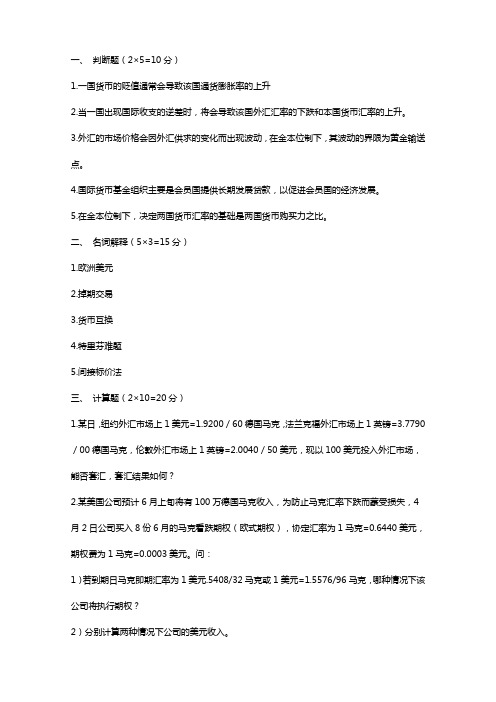
1.一国货币的贬值通常会导致该国通货膨胀率的上升2.当一国出现国际收支的逆差时,将会导致该国外汇汇率的下跌和本国货币汇率的上升。
3.外汇的市场价格会因外汇供求的变化而出现波动,在金本位制下,其波动的界限为黄金输送点。
4.国际货币基金组织主要是会员国提供长期发展贷款,以促进会员国的经济发展。
5.在金本位制下,决定两国货币汇率的基础是两国货币购买力之比。
二、名词解释(5×3=15分)1.欧洲美元2.掉期交易3.货币互换4.特里芬难题5.间接标价法三、计算题(2×10=20分)1.某日,纽约外汇市场上1美元=1.9200/60德国马克,法兰克福外汇市场上1英镑=3.7790/00德国马克,伦敦外汇市场上1英镑=2.0040/50美元,现以100美元投入外汇市场,能否套汇,套汇结果如何?2.某美国公司预计6月上旬将有100万德国马克收入,为防止马克汇率下跌而蒙受损失,4月2日公司买入8份6月的马克看跌期权(欧式期权),协定汇率为1马克=0.6440美元,期权费为1马克=0.0003美元。
问:1)若到期日马克即期汇率为1美元.5408/32马克或1美元=1.5576/96马克,哪种情况下该公司将执行期权?2)分别计算两种情况下公司的美元收入。
1.简述国际收支弹性论的主要内容。
2.简析如何利用财政政策和货币政策的搭配来实现内外均衡。
3. 国际储备与国际清偿能力有何联系和区别?4.简析布雷顿森林体系崩溃的原因。
5.简述本币贬值对国内经济有什么影响?五、论述题(20分)1、根据所学的相关知识,谈谈欧元升值、美元贬值对我国国际储备的影响。
2、谈谈如何控制国际资本流动的不良影响。
六、分析题(10分)2月10日,一家英国集团公司需要营运资本来发展一个项目。
它要求银行按3年期欧洲美元的浮动利率(FRN)融资1亿美元,这些美元将作6个月的掉期交易转换为英镑。
FRN将高于6个月的LIBOR25个基点。
今天LIBOR第一次确定,期间为183天。
中南财大 国际经济学--双语期末试卷

中南财经政法大学——学年第—-学期期末考试试卷国际经济学(闭卷)卷学院专业年级班级课堂号姓名(单选,共20题,每题2分)1, Under Ricardian model, If one country's wage level is very high relative to the other's (the relative wage exceeding the relative productivity ratios), then ( )A.it is not possible that producers in each will find export markets profitable.B.it is not possible that consumers in both countries will enhance their respectivewelfares through imports.C.it is not possible that both countries will find gains from trade.D.it is possible that both will enjoy the conventional gains from trade.2, According to Ricardo, a country will have a comparative advantage in the product in which its ( )bor productivity is relatively low.bor productivity is relatively high.bor mobility is relatively low.bor mobility is relatively high.3, If Australia has more land per worker, and Belgium has more capital per worker, then if trade were to open up between these two countries, ( )A.Australia would export the land-intensive product.B.Belgium would import the capital-intensive product.C.Both countries would export some of each product.D.Trade would not continue since Belgium is a smaller country.4, Under The Specific Factors model, At the production point the production possibility frontier is tangent to a line whose slope is ( )A.the price of manufactures.B.the relative wage.C.the real wage.D.the relative price of manufactures.5, The Heckscher-Ohlin model predicts all of the following except:A.which country will export which product. ( )B.which factor of production within each country will gain from trade.C.the volume of trade.D.that wages will tend to become equal in both trading countries.6, If P C / P F were to increase in the international marketplace, then ( )A.all countries would be better off.B.the terms of trade of cloth exporters improve.C.the terms of trade of food exporters improve.D.the terms of trade of all countries improve.7, When the production possibility frontier shifts out relatively more in one direction, we have ( )A.biased growth.B.unbiased growth.C.immiserizing growth.D.balanced growth.8, If Slovenia were a large country in world trade, then if it instituted a large set of subsidies for its exports, this must ( )A.cause retaliation on the part of its trade partners.B.harm Slovenia's real income.C.improve Slovenia's real income.D.improve the real income of its trade partners.9, A lower tariff on imported steel would most likely benefit ( )A.foreign producers at the expense of domestic consumers.B.domestic manufacturers of steel.C.domestic consumers of steel.D.workers in the steel industry.10, If the poor AID(aid of international development) recipient countries have a higher marginal propensity to consume each and every product than does the United States, then such aid will ( )A.worsen the U.S. terms of trade.B.improve the U.S. terms of trade.C.leave the world terms of trade unaffected.D.worsen the terms of trade of both donor and recipient countries.11, A large country experiencing import-biased economic growth will tend to experience ( )A.no change in terms of trade.B.deteriorating terms of trade.C.improving terms of trade.D.immiserizing terms of trade.12, The most common form of price discrimination in international trade is ( )A.non-tariff barriers.B.V oluntary Export Restraints.C.dumping.D.preferential trade arrangements.13, An appreciation of a country’s currency ( )A.decreases the relative price of its exports and lowers the relative price ofits imports.B.raises the relative price of its exports and raises the relative price of itsimports.C.lowers the relative price of its exports and raises the relative price of itsimports.D.raises the relative price of its exports and lowers the relative price of itsimports.14, Under Purchasing Power Parity, ( )A.E$/E = P i US/ P i E.B.E$/E = P i E / P i US.C.E$/E = P US / P E.D.E$/E = P E / P US.15, Under the monetary approach to the exchange rate, ( )A. a reduction in the money supply will cause immediate currencydepreciation.B. a rise in the money supply will have no effect on exchange rate.C. a rise in the money supply will cause immediate currency appreciation.D. a rise in the money supply will cause a proportional long-run currencydepreciation.16, When EP*/P rises, ( )A.IM will rise.B.IM may rise or fall.C.IM will fall.D.IM is not affected.17, In the short run, a temporary increase in fiscal policy causes ( )A. a shift of the DD curve to the left, an increase in output, andcurrency appreciation.B. a shift of the DD curve to the right, an increase in output, andcurrency appreciation.C. a shift of the DD curve to the right, an increase in output, andcurrency depreciation.D. a shift of the DD curve to the left, a decrease in output, andcurrency depreciation.18, How does a rise in real income affect aggregate demand? ( )A.Y ↑→ Yd ↑→Im ↑→CA ↓→AD ↓, but Y ↑→ Yd ↑→ C ↑→ AD ↑ by more.B.Y ↑→ Yd ↑→Im ↓→CA ↓→AD ↓, but Y ↑→ Yd ↑→ C ↑→ AD ↑ by more.C.Y ↑→ Yd ↑→Im ↑→CA ↑→AD ↑, and Y ↑→ Yd ↑→ C ↑→ AD ↑.D.Y ↑→ Yd ↑→Im ↑→CA ↓→AD ↓, but Y ↑→ Yd ↑→ C ↑→ AD ↑ by less. 19, Under fixed rates, which one of the following statements is the most accurate? ( )A.Monetary policy can affect only output.B.Monetary policy can affect only employment.C.Monetary policy can affect only international reserves.D.Monetary policy can not affect international reserves.20, Under fixed exchange rate, which one of the following statements is the most accurate? ( )A.Devaluation causes a rise in output.B.Devaluation causes a decrease in output.C.Devaluation has no effect on output.共5题,每题6分)1,An Economy can produce goods A using labor and capital and goods B using labor and land. Calculate the effects of the fall in the relative price of goods B on the income of the specific factors capital and land.2, suppose that one country subsidizes its exports and the other country imposes a countervailing tariff that offsets its effect, so that in the end relative price in the second country are unchanged. What happens to the terms of trade? What about welfare in the two countries?3, Describe the pattern of trade under H-O model.4, International trade leads to complete equalization of factor prices. Discuss.5,What is the Fisher Effect? Provide an example.6,Suppose E is fixed at E0 and that the asset markets are in equilibrium.Suddenly output rises. What monetary measures keep the current exchange rate constant given unchanged expectations about the future rate?(共1题,10分)A small country imports peanuts at the price of $10 per bag. The demand curve is D=400-10P. The supply curve is S=50+5PDetermine the free trade equilibrium. Then calculate and graph the following effects: A: The increase in the domestic priceB: The quota rentsC: The consumption distortion lossD: The production distortion loss.四.Essay Questions(共2题,每题10分)1,Comparing the interindustry trade and intraindustry trade.2, Construct a table that will summarize the effects of money market and output market changes on the long-run nominal dollar/ euro exchange rate.中南财经政法大学---------学年第----学期期末考试答案和评分标准课程名称:《国际经济学》()卷课程代号:_02013020_考试形式:闭卷使用对象:1,Because good B uses land, a fall in its relative price will result in a fall in rental rates on land, and an increase in the return to capital.2,The first country is worse off by subsidy and a foreign tariff while the second one is better off by subsidy in the first one and its own tariff.3, Countries tend to export goods whose production is intensive in factors with which they are abundantly endowed.4,This statement is typically "true…but". Under a strict and limited set of assumptions, such as the original Heckscher-Ohlin model which excludes country specific technologies; non- homothetic tastes; factor intensity reversals; large country differences in (relative) factor abundances, and more factors than goods, then it may be demonstrated that internal consistency demands that the above stated sentence is "true". However, the minute one relaxes any of the above listed assumptions one may easily identify solutions, which contradict the factor price equalization theorem.5, All else equal, a rise in a country’s expected inflation rate will eventually cause an equal rise in the interest rate that deposits of its currency offer. Similarly, a fall in the expected inflation rate will eventually cause a fall in the interest rate.6, •Since output rises, demand for domestic money ris es; this increase in money demand normally pushes the domestic interest rate upwards. To prevent appreciation of home currency (given E0is expected) the central bank buys foreign assets in foreign exchange market.•This eliminates excess demand for domes tic money because the central bank issues money to pay for the foreign assets it buys.•The bank increases the money supply in this way until asset markets clear with E = E0 and R = R*.三.计算题A: D-S=50,P=20(3分)B: (20-10)*50=500(3分)C: 100*10*0.5=500(2分)D:50*10*0.5=250(2分)四.论述题1, Interindustry trade reflect comparative advantage while intraindustry trade doesnot reflect comparative advantage.(4分)The pattern of intraindustry trade itself is unpredictable while interindustry trade is predictable.(3分)The relative importance of intraindustry and interindustry trade depends on how similar countries are.(3分)。
国际经济学试题及答案(题库)

国际经济学习题集及参考答案一、填空、选择、判断题(每题1分):第一章:1、国际贸易理论以微观经济学原理为基础,讨论世界范围内的资源配置问题。
2、最常用国际贸易模型的结构形式为两个国家、两种产品(或部门)和两种要素。
3、在完竞争的假设前提下,封闭条件下的相对价格是国际贸易产生的基础。
4、国家间的供给、需求方面的差异是造成相对价格的根源。
5、贸易后,国际均衡价格由两国的供需共同决定,国际均衡价格处于两国封闭下的相对价格之间。
6、国际贸易利益包括两个部分:来自交换的利益和来自专业化的利益。
7、贸易理论主要围绕三个问题展开:国际贸易的格局、国际贸易的条件、国际贸易的收益。
第二章:1、斯密的绝对优势论认为国际贸易的基础是各国之间劳动生产率的绝对差别;李嘉图的比较优势论认为国际贸易的基础是各国之间劳动生产率的相对差别。
2、哈伯勒首先用机会成本概念来阐明比较优势论。
3、重商主义者提倡的国家经济政策有:限制进口和鼓励出口,采取奖金、退税、协定和殖民地贸易等措施鼓励出口。
4、李嘉图认为在国际贸易中起决定作用的不是绝对成本,而是相对成本。
5、斯密的绝对优势论认为国际贸易的基础是各国之间劳动生产率的绝对差别;劳动生产率的比较优势论认为国际贸易的基础是各国之间劳动生产率的相对差别。
6、在李嘉图模型中,生产可能性边界线方程是一个线性方程式,表示A、B两国的PPF曲线是一条直线段。
7、重商主义者提倡的国家经济政策有:限制进口和鼓励出口,采取奖金、退税、协定和殖民地贸易等措施鼓励出口。
8、李嘉图认为在国际贸易中起决定作用的不是绝对成本,而是相对成本。
9、机会成本概念表明:彼种选择的机会成本就构成此种选择的机会成本。
选择题:1、首先用机会成本理论来解释比较优势原理的学者是: C、A、李嘉图B、罗布津斯基C、哈伯勒D、穆勒第三章:1、要素禀赋理论最初是由赫克歇尔和俄林提出的,后经萨缪尔森等人加工不断完善。
2、要素禀赋理论由H-O定理、要素价格均等化定理和罗伯津斯基定理、斯托伯-萨缪尔森定理等构成3、要素价格均等化理论指出国际贸易通过商品价格的均等化会导致要素价格的均等化,从而在世界范围实现资源的最佳配置。
南财大国际经济学1-3套试卷答案
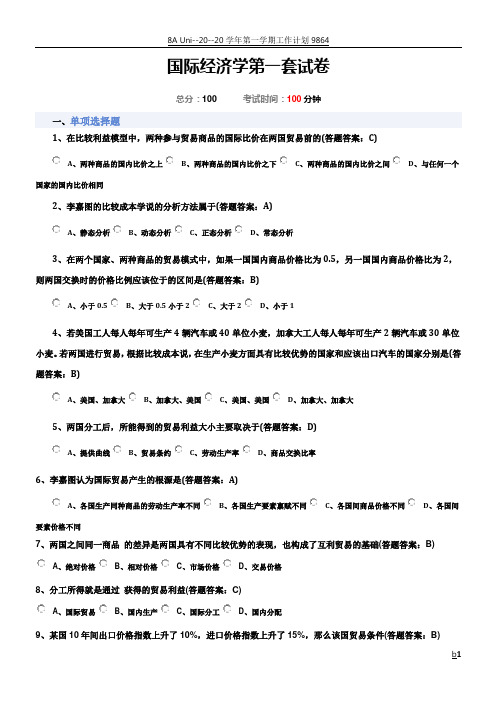
国际经济学第一套试卷总分:100考试时间:100分钟一、单项选择题1、在比较利益模型中,两种参与贸易商品的国际比价在两国贸易前的(答题答案:C)A、两种商品的国内比价之上B、两种商品的国内比价之下C、两种商品的国内比价之间D、与任何一个国家的国内比价相同2、李嘉图的比较成本学说的分析方法属于(答题答案:A)A、静态分析B、动态分析C、正态分析D、常态分析3、在两个国家、两种商品的贸易模式中,如果一国国内商品价格比为0.5,另一国国内商品价格比为2,则两国交换时的价格比例应该位于的区间是(答题答案:B)A、小于0.5B、大于0.5小于2C、大于2D、小于14、若美国工人每人每年可生产4辆汽车或40单位小麦,加拿大工人每人每年可生产2辆汽车或30单位小麦。
若两国进行贸易,根据比较成本说,在生产小麦方面具有比较优势的国家和应该出口汽车的国家分别是(答题答案:B)A、美国、加拿大B、加拿大、美国C、美国、美国D、加拿大、加拿大5、两国分工后,所能得到的贸易利益大小主要取决于(答题答案:D)A、提供曲线B、贸易条约C、劳动生产率D、商品交换比率6、李嘉图认为国际贸易产生的根源是(答题答案:A)A、各国生产同种商品的劳动生产率不同B、各国生产要素禀赋不同C、各国间商品价格不同D、各国间要素价格不同7、两国之间同一商品的差异是两国具有不同比较优势的表现,也构成了互利贸易的基础(答题答案:B)A、绝对价格B、相对价格C、市场价格D、交易价格8、分工所得就是通过获得的贸易利益(答题答案:C)A、国际贸易B、国内生产C、国际分工D、国内分配9、某国10年间出口价格指数上升了10%,进口价格指数上升了15%,那么该国贸易条件(答题答案:B)A、改善B、恶化C、不变D、不能确定10、以下各项中哪一项不会促进国家间木材的自由贸易(答题答案:A)A、贸易前各国木树价格相等B、追求利润的木树价格套利C、国家间存在木材供给的差别D、国家间存在木材需求的差别11、在分析生产要素价格均等化过程,有一系列的假设条件,下列不是其假设条件的有(答题答案:D)A、生产要素在一国范围内的各部门间自由流动B、不存在贸易障碍和运输费用C、生产要素充分利用D、生产要素在国与国之间自由流动12、对里昂惕夫之谜的解释较为典型的观点不包括(答题答案:B)A、自然资源B、汇率因素C、要素密集度转换D、贸易壁垒13、如果A国可用1个工时生产3个单位的x产品或3个单位的y产品,B国可用1个工时生产2单位的x 产品或1个单位的y产品,而且如果劳动是惟一的投入,那么(答题答案:C)A、A国在两种商品的生产上均具有比较优势B、B国在两种商品的生产上均具有绝对优势C、A国在两种商品的生产上均具有绝对劣势D、B国在两种商品的生产上均具有比较优势14、提出要素禀赋理论的是(答题答案:B)A、李嘉图B、俄林C、里昂惕夫D、马歇尔15、分工与自由贸易使交换的两国获得更多的福利,这表现在(答题答案:B)A、两国的生产组合处在更高的生产可能性曲线上B、两国的消费组合处在更高的社会无差异曲线上C、两国的消费组合处在更高的生产可能性曲线上D、两国的生产组合处在更高的社会无差异曲线上16、用相对要素价格定义要素禀赋考虑了(答题答案:C)A、要素的供给B、要素的需求C、要素的供求D、要素的分配17、要素价格均等化定理又称(答题答案:D)A、H-O定理B、H-S定理C、S-S定理D、H-O-S定理18、()兴起于二战后发达国家之间的双向贸易(答题答案:A)A、产业内贸易B、产业间贸易C、制成品与初级产品的贸易D、产品内贸易19、美国经济学家波斯纳提出的(),以各国技术水平的差异为起点,分析国际贸易的成因(答题答案:B)A、偏好相似论B、技术差距论C、产品生命周期理论D、要素禀赋论20、与中间产品贸易对应的国际分工是(答题答案:D)A、产业间分工B、产业内分工C、发达国家之间的分工D、产品内分工21、()与技术差距论放松了传统比较优势理论的假设,考虑技术扩散对产品国际化转移的影响(答题答案:C)A、产业内贸易理论B、产品内贸易理论C、产品生命周期理论二、多项选择题1、从博弈论角度看,国际贸易是(答题答案:BC)A、零和博弈B、正和博弈C、双赢博弈D、负和博弈2、要素价格均等化定理的假设包括(答题答案:ABC)A、完全竞争的市场B、国家间没有贸易壁垒C、各国具有相同的生产技术D、各国具有同样的收入水平3、新要素理论包括(答题答案:ABCD)A、自然资源说B、技术要素说C、人力资本要素说D、研发要素说4、通过商品的国际贸易,两国同质要素的价格变化是(答题答案:ABC)A、趋于绝对均等B、趋于相对均等C、原来便宜的要素价格会上升D、原来便宜的要素价格继续下跌5、影响商品价格的因素有(答题答案:ABCD)A、要素的价格B、生产技术C、商品的供给D、商品的需求6、可以定义要素丰裕度的方法是(答题答案:CD)A、一国要素的绝对数量B、一国要素的绝对价格C、两国要素的数量比率D、两国要素的相对价格7、耐克公司一般如何布局不同的生产环节?(答题答案:ABC)A、缝制在发展中国家B、设计在美国C、品牌推广在发达国家D、没有特殊的布局8、技术落后国家对先进技术学习模仿的滞后包括(答题答案:BCD)A、信息滞后B、需求滞后C、反应滞后D、掌握滞后三、判断题1、一个产品不可能同时既具有绝对优势,又具有相对优势。
国际经济学试题及答案
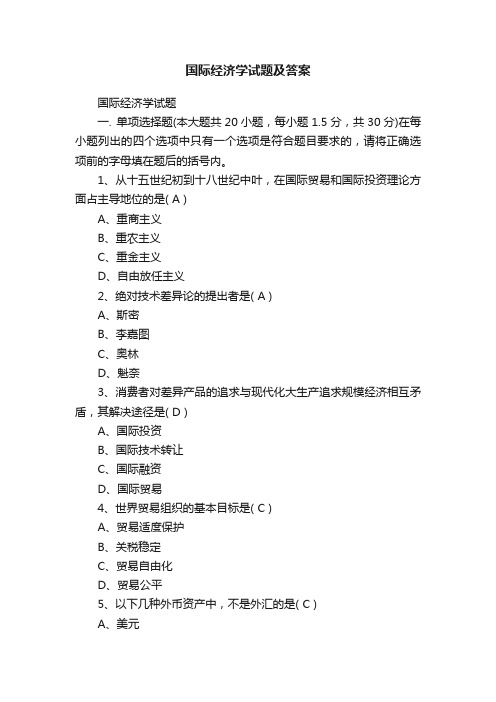
国际经济学试题及答案国际经济学试题一. 单项选择题(本大题共20小题,每小题1.5分,共30分)在每小题列出的四个选项中只有一个选项是符合题目要求的,请将正确选项前的字母填在题后的括号内。
1、从十五世纪初到十八世纪中叶,在国际贸易和国际投资理论方面占主导地位的是( A )A、重商主义B、重农主义C、重金主义D、自由放任主义2、绝对技术差异论的提出者是( A )A、斯密B、李嘉图C、奥林D、魁奈3、消费者对差异产品的追求与现代化大生产追求规模经济相互矛盾,其解决途径是( D )A、国际投资B、国际技术转让C、国际融资D、国际贸易4、世界贸易组织的基本目标是( C )A、贸易适度保护B、关税稳定C、贸易自由化D、贸易公平5、以下几种外币资产中,不是外汇的是( C )A、美元B、英镑C、港元D、越南盾6、在发展中国家利用外资的主要渠道中,不需要偿还的引资方式是( D )A、官方贷款B、发行债券C、银行贷款D、外商直接投资7、在下列投资方式中,属于国际直接投资的是(D)A.购买外国政府债券B.购买外国企业债券C.向外国企业提供商业贷款D.在国外开设合资企业8、赫克歇尔一俄林模型认为国际贸易的根本原因是(A)A.各国生产要素禀赋不同B.各国劳动生产率不同C.各国技术水平不同以D.各国产品技术含量不同9、属于非关税壁垒的措施是(D)A.反倾销税B.反补贴税C.进口附加税D.国内最低限价10、在比较利益模型中,两种参与贸易商品的国际比价( C)A.在两国贸易前的两种商品的国内比价之上B.在两国贸易前的两种商品的国内比价之下C.在两国贸易前的两种商品的国内比价之间D.与贸易前的任何一个国家的国内比价相同11、比较利益理论认为国际贸易的驱动力是(A )A.劳动生产率的差异B.技术水平的差异C.产品品质的差异D.价格的差异12、在绝对技术差异理论与相对技术差异理论中,机会成本是(D )A.递增B.递减C.先递增后递减D.不变13、不能解释产业内贸易现象的理论有(B )A.重叠需求理论B.要素比例理论B.规模经济理论 D.垄断竞争理论14、能反映规模经济理论本意的是(B )A.规模报酬递减B.规模报酬递增C.规模报酬不变D.规模成本递增15、下列不属于保护贸易学说的理论有(D )A.幼稚工业理论B.夕阳工业理论C.国防论D.资源禀赋论16、最佳关税水平应等于(B )A.零进口关税B.零进口关税与禁止性关税之间的水平C.禁止性关税D.禁止性关税以上17、下述哪一种不属于投机性外汇交易(D )A.双边套汇B.多边套汇C.套利D.套期保值18、下述几种货币中,哪一种是实行联合浮动的货币( D)A.英镑B.日元C.美元D.人民币19、劳动力在各国间的流动通常会使劳动力流入国( A)A.财政总收入增加,公共设施利用率提高B.财政总收入增加,公共设施利用率下降C.财政总收入减少,公共设施利用率提高D.财政总收入减少,公共设施利用率下降20、下述哪一种属于国际收支的事后项目(D )A.进出口B.利息收支C.直接投资D.特别提款权变动二、多项选择题(本大题共5小题,每小题3分,共15分)在每小题列出的五个选项中有二至五个选项是符合题目要求的,请将正确选项前的字母填在题后的括号内。
国际经济学_中南财经政法大学中国大学mooc课后章节答案期末考试题库2023年

国际经济学_中南财经政法大学中国大学mooc课后章节答案期末考试题库2023年1.在植物保护专业中,Pest指()答案:有害生物2.按我国农药急性毒性分级标准,高毒农药经口服LD50为()答案:<50 mg/kg3.农药生物降解种最普遍、最重要降解是()答案:微生物降解4.下列农药分散体系,易发生相分离,导致不稳定性的是()答案:多相体系5.以下农药助剂不属于表面活性剂的是()答案:溶剂6.在生物测定实验中必须设置标准药剂对照,标准药剂指的是()答案:同类化合物中已对某种病虫害确定是有效的药剂7.有机磷类与氨基甲酸酯类杀虫剂的作用于昆虫体内的()答案:AChE8.以下杀虫剂,不属于有机磷类杀虫剂的是()答案:灭多威9.鱼藤酮的主要作用机理是()答案:抑制线粒体呼吸链10.甲霜灵具有保护和治疗作用的内吸性杀菌剂,其作用靶标是()答案:RNA聚合酶I11.不属于甲霜灵防治对象的是()答案:镰刀菌12.属于旁路氧化抑制剂的是()答案:水杨羟肟酸13.关于除草剂生物化学选择性,下面描述不正确的是()答案:植物茎叶或根系对除草剂吸收与输导的差异而产生的选择性,称为生物化学选择性14.野燕麦对野麦畏最敏感的部位是()答案:生长点15.被列为第六类植物激素的是()答案:甾醇类16.以下不属于国家标准中对水生生物风险评估的是()。
答案:蟾蜍17.农药经营许可证有效期为()年。
答案:518.下列哪些属于生物源农药:答案:井冈霉素枯草芽孢杆菌19.农药进入环境后,在环境中有着复杂的迁移转化过程,包括:答案:挥发降解沉积吸附20.农药的生物富集作用的大小与哪些因素有关:答案:生物对农药的代谢能力生物的种类不溶性和分配系数生物体内的脂肪含量21.20世纪70年代是人类将环境保护意识和农药科技创新相结合的新纪元,人们对农药观念的转变包括:答案:从单纯的化学防治进入到综合防治。
从高剂量调整为低剂量施药。
从有毒、有效转变为低毒、高效。
南京财经大学成人高等教育国际经济学试卷2
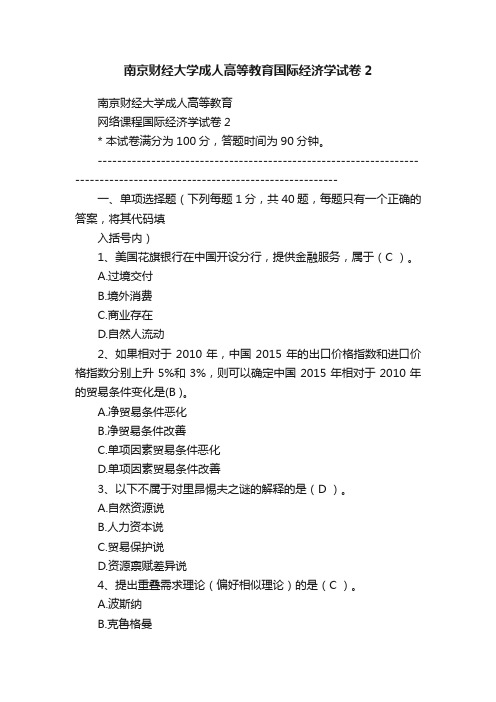
南京财经大学成人高等教育国际经济学试卷2南京财经大学成人高等教育网络课程国际经济学试卷2* 本试卷满分为100分,答题时间为90分钟。
------------------------------------------------------------------------------------------------------------------------一、单项选择题(下列每题1分,共40题,每题只有一个正确的答案,将其代码填入括号内)1、美国花旗银行在中国开设分行,提供金融服务,属于(C )。
A.过境交付B.境外消费C.商业存在D.自然人流动2、如果相对于2010年,中国2015年的出口价格指数和进口价格指数分别上升5%和3%,则可以确定中国2015年相对于2010年的贸易条件变化是(B )。
A.净贸易条件恶化B.净贸易条件改善C.单项因素贸易条件恶化D.单项因素贸易条件改善3、以下不属于对里昂惕夫之谜的解释的是(D )。
A.自然资源说B.人力资本说C.贸易保护说D.资源禀赋差异说4、提出重叠需求理论(偏好相似理论)的是(C )。
A.波斯纳B.克鲁格曼D.波特5、普雷维什认为“中心-外围”体系的特点不包括( D )。
A.整体性B.差异性C.不平等性D.动态性6、李斯特把各国经济成长分为五个阶段,其中需要采取保护政策的是( C)。
A.畜牧业时期B.农业时期C.农工业时期D.农工商业时期。
7、15—17世纪资本原始积累时期代表商业资本利益的经济思想和政策体系的是( B)。
A.凯恩斯主义B.重商主义C.新贸易保护主义D.幼稚工业保护论8、英国1846年废除《谷物法》标志着自由贸易的开始,自由贸易达到最高峰是(A )。
A.1870年B.1875年C.1880年D.1900年9、某国对一商品的征税方法是:货值的15%,每件加征20美元,这种征税方法叫( D )。
A.选择税B.从价税C.从量税10、与复式税则相比,单式税则(D )。
- 1、下载文档前请自行甄别文档内容的完整性,平台不提供额外的编辑、内容补充、找答案等附加服务。
- 2、"仅部分预览"的文档,不可在线预览部分如存在完整性等问题,可反馈申请退款(可完整预览的文档不适用该条件!)。
- 3、如文档侵犯您的权益,请联系客服反馈,我们会尽快为您处理(人工客服工作时间:9:00-18:30)。
南财大国际经济学-套试卷答案————————————————————————————————作者:————————————————————————————————日期:国际经济学第一套试卷总分:100考试时间:100分钟一、单项选择题1、在比较利益模型中,两种参与贸易商品的国际比价在两国贸易前的(答题答案:C)A、两种商品的国内比价之上B、两种商品的国内比价之下C、两种商品的国内比价之间D、与任何一个国家的国内比价相同2、李嘉图的比较成本学说的分析方法属于(答题答案:A)A、静态分析B、动态分析C、正态分析D、常态分析3、在两个国家、两种商品的贸易模式中,如果一国国内商品价格比为0.5,另一国国内商品价格比为2,则两国交换时的价格比例应该位于的区间是(答题答案:B)A、小于0.5B、大于0.5小于2C、大于2D、小于14、若美国工人每人每年可生产4辆汽车或40单位小麦,加拿大工人每人每年可生产2辆汽车或30单位小麦。
若两国进行贸易,根据比较成本说,在生产小麦方面具有比较优势的国家和应该出口汽车的国家分别是(答题答案:B)A、美国、加拿大B、加拿大、美国C、美国、美国D、加拿大、加拿大5、两国分工后,所能得到的贸易利益大小主要取决于(答题答案:D)A、提供曲线B、贸易条约C、劳动生产率D、商品交换比率6、李嘉图认为国际贸易产生的根源是(答题答案:A)A、各国生产同种商品的劳动生产率不同B、各国生产要素禀赋不同C、各国间商品价格不同D、各国间要素价格不同7、两国之间同一商品的差异是两国具有不同比较优势的表现,也构成了互利贸易的基础(答题答案:B)A、绝对价格B、相对价格C、市场价格D、交易价格8、分工所得就是通过获得的贸易利益(答题答案:C)A、国际贸易B、国内生产C、国际分工D、国内分配9、某国10年间出口价格指数上升了10%,进口价格指数上升了15%,那么该国贸易条件(答题答案:B)A、改善B、恶化C、不变D、不能确定10、以下各项中哪一项不会促进国家间木材的自由贸易(答题答案:A)A、贸易前各国木树价格相等B、追求利润的木树价格套利C、国家间存在木材供给的差别D、国家间存在木材需求的差别11、在分析生产要素价格均等化过程,有一系列的假设条件,下列不是其假设条件的有(答题答案:D)A、生产要素在一国范围内的各部门间自由流动B、不存在贸易障碍和运输费用C、生产要素充分利用D、生产要素在国与国之间自由流动12、对里昂惕夫之谜的解释较为典型的观点不包括(答题答案:B)A、自然资源B、汇率因素C、要素密集度转换D、贸易壁垒13、如果A国可用1个工时生产3个单位的x产品或3个单位的y产品,B国可用1个工时生产2单位的x产品或1个单位的y产品,而且如果劳动是惟一的投入,那么(答题答案:C)A、A国在两种商品的生产上均具有比较优势B、B国在两种商品的生产上均具有绝对优势C、A国在两种商品的生产上均具有绝对劣势D、B国在两种商品的生产上均具有比较优势14、提出要素禀赋理论的是(答题答案:B)A、李嘉图B、俄林C、里昂惕夫D、马歇尔15、分工与自由贸易使交换的两国获得更多的福利,这表现在(答题答案:B)A、两国的生产组合处在更高的生产可能性曲线上B、两国的消费组合处在更高的社会无差异曲线上C、两国的消费组合处在更高的生产可能性曲线上D、两国的生产组合处在更高的社会无差异曲线上16、用相对要素价格定义要素禀赋考虑了(答题答案:C)A、要素的供给B、要素的需求C、要素的供求D、要素的分配17、要素价格均等化定理又称(答题答案:D)A、H-O定理B、H-S定理C、S-S定理D、H-O-S定理18、()兴起于二战后发达国家之间的双向贸易(答题答案:A)A 、产业内贸易B 、产业间贸易C 、制成品与初级产品的贸易D 、产品内贸易19、美国经济学家波斯纳提出的( ),以各国技术水平的差异为起点,分析国际贸易的成因(答题答案:B)A 、偏好相似论B 、技术差距论C 、产品生命周期理论D 、要素禀赋论20、与中间产品贸易对应的国际分工是(答题答案:D)A 、产业间分工B 、产业内分工C 、发达国家之间的分工D 、产品内分工21、( )与技术差距论放松了传统比较优势理论的假设,考虑技术扩散对产品国际化转移的影响(答题答案:C)A 、产业内贸易理论B 、产品内贸易理论C 、产品生命周期理论二、多项选择题1、从博弈论角度看,国际贸易是(答题答案:BC)A 、零和博弈B 、正和博弈C 、双赢博弈D 、负和博弈2、要素价格均等化定理的假设包括(答题答案:ABC)A 、完全竞争的市场B 、国家间没有贸易壁垒C 、各国具有相同的生产技术D 、各国具有同样的收入水平 3、新要素理论包括(答题答案:ABCD)A 、自然资源说B 、技术要素说C 、人力资本要素说D 、研发要素说4、通过商品的国际贸易,两国同质要素的价格变化是(答题答案:ABC)A 、趋于绝对均等B 、趋于相对均等C 、原来便宜的要素价格会上升D 、原来便宜的要素价格继续下跌 5、影响商品价格的因素有(答题答案:ABCD)A 、要素的价格B 、生产技术C 、商品的供给D 、商品的需求6、可以定义要素丰裕度的方法是(答题答案:CD)A 、一国要素的绝对数量B 、一国要素的绝对价格C 、两国要素的数量比率D 、两国要素的相对价格 7、耐克公司一般如何布局不同的生产环节?(答题答案:ABC)A 、缝制在发展中国家B 、设计在美国C 、品牌推广在发达国家D 、没有特殊的布局8、技术落后国家对先进技术学习模仿的滞后包括(答题答案:BCD)A、信息滞后B、需求滞后C、反应滞后D、掌握滞后三、判断题1、一个产品不可能同时既具有绝对优势,又具有相对优势。
(答题答案:B)A、是B、否2、只要给定两个国家、两种商品条件,双方必定形成互为有利的国际分工(答题答案:B)A、是B、否3、交易所得就是通过国际分工获得的贸易利益(答题答案:B)A、是B、否4、如果两国贸易前相对价格是相同的,就不会有生产分工了(答题答案:A)A、是B、否5、一国在贸易中的所得可以分为交易所得和分工所得(答题答案:A)A、是B、否6、如果外国对本国商品的需求程度大于本国对外国商品的需求程度,贸易条件就对本国有利(答题答案:A)A、是B、否7、绝对利益说和比较利益说都是建立在成本差异分析的基础上(答题答案:A)A、是B、否8、当两国生产同一种产品的技术相同时,决定要素投入比例的主要影响因素是要素相对价格(答题答案:A)A、是B、否9、人力资本说不仅考虑了物质资本,也考虑了劳动者接受的培训、教育等因素(答题答案:A)A、是B、否10、赫-俄模型并不要求各国需求偏好、收入分配和生产技术完全相同(答题答案:A)A、是B、否11、要素密集度指的是一国的要素丰裕情况(答题答案:B)A、是B、否12、根据H-O定理,自由贸易将会导致各国间同质要素相对的和绝对的收益均等化(答题答案:A)A、是B、否13、一国应出口密集使用其相对丰裕要素所生产的产品,进口密集使用其相对稀缺要素所生产的产品(答题答案:A)A、是B、否14、要素禀赋理论分析了国家之间比较优势差异产生的一种原因(答题答案:A)A、是B、否15、产业间贸易以比较优势或要素禀赋为基础,而产业内贸易以市场的不完全性及其带来的规模经济为基础(答题答案:A)A、是B、否16、产品内分工与产业间分工、产业内分工同时存在于各国之间。
(答题答案:A)A、是B、否17、与技术差距论所包含的相对静态特征不同,产品生命周期理论强调的是贸易模式随产品周期的动态变化过程。
(答题答案:A)A、是B、否18、产业间分工带来大量的中间产品贸易(答题答案:B)A、是B、否19、在产品成熟阶段,主要是发展中国家生产并出口,原来的创新国、模仿国成为进口国(答题答案:B)A、是B、否20、微笑曲线表明上游和下游环节具有较高附加值,中游的加工组装环节附加值较低(答题答案:A)A、是B、否21、当前国际分工主要是由跨国公司主导的,跨国公司占据了对价值形成最有影响和支配的环节(答题答案:A)A、是B、否国际经济学第二套试卷总分:100考试时间:100分钟一、单项选择题1、早期重商主义绝对禁止(答题答案:D)A、纸币外流B、资本外流C、货物外流D、货币外流2、欧洲资本原始积累时期代表商业资本利益的经济思想和政策体系为(答题答案:A)A、重商主义B、凯恩斯主义C、幼稚工业论D、新贸易保护主义3、从十五世纪初到十八世纪中叶,在国际贸易理论方面占主导地位的是(答题答案:A)A、重商主义B、重农主义C、重金主义D、自由放任主义4、“货币产生贸易,贸易增加货币”观点的提出者是(答题答案:A)A、威廉·斯塔福B、托马斯·孟C、亚当·斯密D、大卫·李嘉图5、最先用博弈论来分析战略性的贸易与产业政策的是(答题答案:C)A、克鲁格曼B、李普西C、布兰德和斯潘塞D、迪克西特6、早期重商主义被称为重金主义,晚期重商主义也称为(答题答案:A)A、贸易差额论B、贸易利润论C、商业差额论D、商业利润论7、下列哪一项不是非关税壁垒与关税壁垒相比所具有的特点(答题答案:D)A、灵活性B、针对性C、隐蔽性D、稳定性8、战略性贸易政策不适宜在哪一种市场条件下运用(答题答案:A)A、完全竞争B、自然垄断C、垄断竞争D、寡头垄断9、发达国家进口关税结构一般具备的特点是()(答题答案:B)A、制成品税率〈原材料税率〈中间投入品税率B、原材料税率〈中间投入品税率〈制成品税率C、原材料税率〈制成品税率〈中间投入品税率D、中间投入品税率〈原材料税率〈制成品税率10、一般情况下,下列各大类商品中进口关税税率最低的是(答题答案:C)A、工业制成品B、半成品C、原料D、劳动密集型产品11、对广泛使用贸易壁垒的最为可能的解释是(答题答案:D)A、国内生产者的无知B、国内消费者的无知C、出口者的无知D、官员所使用的福利度量标准不是经济理论分析中所使用的12、国际经济一体化组织的建立对各成员国产生的静态影响包括(答题答案:A)A、贸易创造和贸易转移B、贸易创造和大市场效应C、贸易转移和竞争效应D、大市场效应和竞争效应13、各国政府更加倾向于采用配额而不是关税,这是因为( ) (答题答案:B)A、配额可以给政府带来更多的收入B、关税的改变要受到国际贸易协定的严格控制C、配额制不阻碍国内市场竞争D、配额制更不利于腐败的政府官员进行寻租14、自由贸易时,美国自行车价格是200美元,进口原料成本是140美元。
如果对自行车和原料分别征收10%和5%的进口税,那么自行车的有效保护率是(答题答案:D)A、10%B、17%C、5%D、21.30%15、在经济一体化的自由贸易区形式下,各成员国之间(答题答案:A)A、废除关税限制B、执行某些共同的经济政策C、建立对非成员国的共同关税D、生产要素可以自由移动16、以下哪些组织形式不属于国际经济一体化组织(答题答案:D)A、自由贸易区B、关税同盟C、欧盟D、北约17、关税同盟的动态效应是(答题答案:C)A、贸易创造B、贸易转移C、市场扩大D、贸易损失18、成员国之间生产要素不能自由流动的国际经济一体化形式是(答题答案:A)A、关税同盟B、共同市场C、经济同盟D、完全经济一体化19、协议性国际分工需要具备的条件是(答题答案:A)A、能够获得规模经济的商品B、商品的利益有明显差别C、两国禀赋差异大D、两国文化接近20、如果在欧盟成立后,英国人会去购买以更低效率生产的爱尔兰奶酪,而不是从新西兰进口更便宜的奶酪,这大概反映了(答题答案:B)A、贸易创造B、贸易转移C、政府的干预D、人们的常识21、提出大市场理论的学者是(答题答案:D)A、李嘉图B、李斯特C、李普曼D、德钮二、多项选择题1、重商主义的政策主张有(答题答案:ABCD)A、管制金银货币B、实行外贸垄断C、限制进口D、促进出口2、管理贸易理论的特点有(答题答案:ABCD)A、贸易管理法律化B、更多地单边管理双边协调C、以非关税措施为主D、跨国公司在管理贸易中的地位不断上升3、战略性贸易理论存在的限制条件包括(答题答案:ABC)A、政府拥有准确的信息B、足够的进入壁垒使新厂商无法加入C、别国政府不采取报复措施D、完全竞争的市场4、非关税壁垒的特点是(答题答案:BCD)A、公开透明B、隐蔽性C、灵活性D、针对性5、有效保护率考虑的因素包括(答题答案:ABC)A、最终产品税率B、中间产品税率C、原材料税率D、原材料价格6、小国征收进口关税后的影响是(答题答案:BC)A、生产者受损B、生产者受益C、消费者受损D、消费者受益7、经济一体化组织的动态效应包括(答题答案:ABCD)A、规模经济B、扩大投资C、加剧竞争D、技术进步8、经济一体化的理论包括(答题答案:ABC)A、关税同盟理论B、大市场理论C、协议性国际分工理论D、要素动态禀赋理论三、判断题1、李斯特认为,财富的生产力比财富本身更重要(答题答案:A)A、是B、否2、从对消费者福利影响的角度看,关税优于补贴(答题答案:B)A、是B、否3、战略性产业具有高投资额、高风险、正外部性的特点,因此一般需要政府干预(答题答案:A)A 、是B 、否4、重商主义认为国际贸易是零和博弈,一国所得就是另一国所失(答题答案:A)A 、是B 、否5、晚期重商主义又称重金主义或者货币差额论(答题答案:B)A 、是B 、否6、管理贸易是一种介于自由贸易和保护贸易之间、以协调为中心、以政府干预为主导的贸易制度(答题答案:A)A 、是B 、否7、进口配额可以将进口设定在一个确定的水平上,进口关税对贸易具有同等效应。
